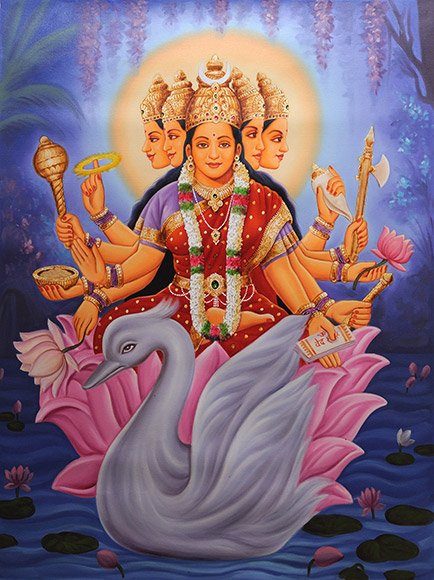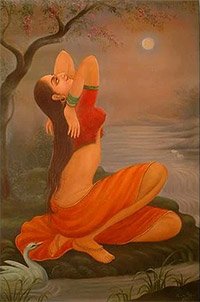Kridanaka, Krīḍanaka: 12 definitions
Introduction:
Kridanaka means something in Hinduism, Sanskrit, Jainism, Prakrit. If you want to know the exact meaning, history, etymology or English translation of this term then check out the descriptions on this page. Add your comment or reference to a book if you want to contribute to this summary article.
In Hinduism
Chandas (prosody, study of Sanskrit metres)
Source: Journal of the University of Bombay Volume V: Apabhramsa metres (2)1) Krīḍanaka (क्रीडनक) is the name of a catuṣpadi metre (as popularly employed by the Apabhraṃśa bards), as discussed in books such as the Chandonuśāsana, Kavidarpaṇa, Vṛttajātisamuccaya and Svayambhūchandas.—Krīḍanaka has 20 mātrās in each of its four lines, divided into the groups of 4, 4, 4, [SIS or IIIS] and [IS] mātrās.
2) Krīḍanaka (क्रीडनक) is another catuṣpadi metre having 20 mātrās in each of its four lines, divided into the groups of 4, 4, 4, 5 and 3 mātrās, with yati after the 8th.

Chandas (छन्दस्) refers to Sanskrit prosody and represents one of the six Vedangas (auxiliary disciplines belonging to the study of the Vedas). The science of prosody (chandas-shastra) focusses on the study of the poetic meters such as the commonly known twenty-six metres mentioned by Pingalas.
Kama-shastra (the science of Love-making)
Source: Shodhganga: Elements of Art and Architecture in the Trtiyakhanda of the Visnudharmottarapurana (kama)Krīḍanaka (क्रीडनक) or Vālakrīḍanaka refers to the “making of dolls” and represents one of the “sixty four kinds of Art”, according to the Kāmasūtra of Vātsyāyaṇa.—Indian tradition, basically includes sixty four Art forms are acknowledged. The references of sixty four kinds of kalā are found in the Bhāgavatapurāṇa, Śaiva-Tantras, Kāmasūtra of Vātsyāyaṇa etc.

Kamashastra (कामशास्त्र, kāmaśāstra) deals with ancient Indian science of love-making, passion, emotions and other related topics dealing with the pleasures of the senses.
In Jainism
Jain philosophy
Source: archive.org: Anekanta Jaya Pataka of Haribhadra SuriKrīḍanaka (क्रीडनक) refers to a “toy”, as occurring in the Anekāntajayapatākā-prakaraṇa, a Śvetāmbara Jain philosophical work written by Haribhadra Sūri.—[Cf. Vol. I, P. 356, l. 3]—‘Krīḍanaka’ means a toy. The Hindi word is derived from this.
-
Languages of India and abroad
Sanskrit dictionary
Source: DDSA: The practical Sanskrit-English dictionaryKrīḍanaka (क्रीडनक).—A play-thing, toy. लीलया व्यनुदत्तांस्तान्बालः क्रीटनकानिव (līlayā vyanudattāṃstānbālaḥ krīṭanakāniva) Bhāgavata 3.2.3. Ś.7.
-krīḍanakatayā ind. After a manner of a plaything; Bhāgavata 5.26.32.
Derivable forms: krīḍanakaḥ (क्रीडनकः).
See also (synonyms): krīḍanakam, krīḍanīyam, krīḍanīyakam.
Source: Cologne Digital Sanskrit Dictionaries: Benfey Sanskrit-English DictionaryKrīḍanaka (क्रीडनक).—[krīḍana + ka], m. (and n.) A plaything, [Śākuntala, (ed. Böhtlingk.)] 105, 10; [Bhāgavata-Purāṇa, (ed. Burnouf.)] 3, 2, 30.
Source: Cologne Digital Sanskrit Dictionaries: Cappeller Sanskrit-English DictionaryKrīḍanaka (क्रीडनक).—[masculine] plaything, toy.
Source: Cologne Digital Sanskrit Dictionaries: Monier-Williams Sanskrit-English Dictionary1) Krīḍanaka (क्रीडनक):—[from krīḍ] mf(ikā)n. playing, jesting, [cf. Lexicographers, esp. such as amarasiṃha, halāyudha, hemacandra, etc.]
2) [v.s. ...] m. a plaything, [Mahābhārata; Śakuntalā; Bhāgavata-purāṇa] etc.
Source: Cologne Digital Sanskrit Dictionaries: Yates Sanskrit-English DictionaryKrīḍanaka (क्रीडनक):—(kaṃ) 1. n. A plaything.
Source: DDSA: Paia-sadda-mahannavo; a comprehensive Prakrit Hindi dictionary (S)Krīḍanaka (क्रीडनक) in the Sanskrit language is related to the Prakrit words: Kīlaṇaa, Kīlāvaṇaya.
[Sanskrit to German]
Sanskrit, also spelled संस्कृतम् (saṃskṛtam), is an ancient language of India commonly seen as the grandmother of the Indo-European language family (even English!). Closely allied with Prakrit and Pali, Sanskrit is more exhaustive in both grammar and terms and has the most extensive collection of literature in the world, greatly surpassing its sister-languages Greek and Latin.
See also (Relevant definitions)
Starts with: Kridanakala, Kridanakata, Kridanakataya.
Ends with: Balakridanaka, Devakridanaka, Kumarikridanaka, Manavakakridanaka, Pamshukridanaka, Pankakridanaka, Sahapamshukridanaka.
Full-text: Kridanakata, Kumarikridanaka, Pankakridanaka, Manavakakrida, Kridaniyaka, Kridaniya, Balakridanaka, Kridanakataya, Kilavanaya, Pankakrida, Manavakakridanaka, Kridanika, Kilanaa, Kridenak, Kridapanaka, Pamsukridana, Manavaka.
Relevant text
Search found 1 books and stories containing Kridanaka, Krīḍanaka, Krīḍānaka; (plurals include: Kridanakas, Krīḍanakas, Krīḍānakas). You can also click to the full overview containing English textual excerpts. Below are direct links for the most relevant articles:
The Shiva Purana (by J. L. Shastri)
Chapter 7 - The worship of Śiva < [Section 6 - Kailāsa-saṃhitā]